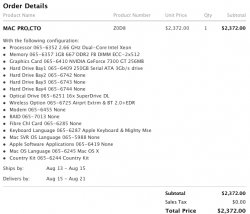Exactly! Here's how a Mac Pro adds up in the USofA (where it's DIRT CHEAP compared to most other places).
Mac Pro 2.66 GHz, 1 GB, 250 GB ............... $2499
BlueTooth + WiFi ...................................... $79
camera, microphone, speakers ................... $220 (estimate)
23" ACD (or a higher-rated Dell 2407WFP) .... $899 (or $699)
Total .................................................... $3500 - $3700
So, the entry-level Pro system costs twice as much as a 24" iMAc -- with a smaller disk, only 1 GB of horribly expensive ECC RAM, and an entirely insignificant 7% performance advantage (see MacWorld benchmarks).
IMO, Apple screwed the pooch with the ALU iMac release. They now offer absolutely nothing with a reasonable-quality display and mid-range CPU/HDD performance -- short of a $3500 Mac Pro system...
...and at $3500, it's still only mid-range CPU/HDD performance!
LK
You have to pick and choose with the right balance of cost and quality.
I have a Mac Pro 2.66 with 3 GB of RAM, SuperDrive, BlueTooth, AirPort / WiFi, a stock 250 GB hard drive, and aftermarket 500 GB Western Digital hard drive, and two 19-inch Widescreen LCD monitors.
I have less than $3000 into the whole system, and it was all purchased new.
The thing is, you have to shop around, and pick your components based on personal observation and quality rather than brand reputation and the assumption that nothing else will equal that product in quality.
I've got two Hanns.G 19-inch wide-screen LCD monitors. They cost me about $160 each at my local retailer (Fred Meyer / Kroger grocery store). Each monitor includes both Digital and Analog video inputs, and also have stereo speakers built-in. They came with the Digital and Analog video cables as well as the audio input cable and power cable. I'm using the Digital video inputs (they plugged right into my Mac Pro's two video out's).
Their quality is absolutely amazing. There are absolutely no dead or stuck pixels. And, the first time you look at them, they are so bright that you feel like you're staring into the sun (although your eyes adjust after a few hours). The color is even and consistent across the screen, and the surface is remarkably durable (they held-up to my daughter writing on them with a sharp mechanical pencil without leaving any permanent markings or damage in the surface - can't say the same for the other panels she wrote on around the house).
I have used a lot of monitors, and these are absolutely the best I have ever used. Including Apple's monitors. And, in comparison to all the iMac's I've owned, these monitors absolutely shame Apple's iMac panels.
I ordered the system stock with the exception of adding bluetooth and Airport Extreme / WiFi. And, had $2372 (looking at the invoice now) into the purchase. I just did a screen-grab of my invoice and included that in this post. Naturally, I left out the personal details and such that are more private (card number, address, etc.).
I ordered an additional 2 GB of RAM from Other World Computing and an additional 500 GB hard drive. And, had $300 into that including shipping.
Now, I did have another DVD-Writer available. So, I stuck that in. No cost, so might as well use it

So, I have dual SuperDrives in there now.
Adding it all up, I have $2992 total invested into this machine.
That compares very favorably with the price of a similar iMac system.
To get an iMac of similar specs, I'd have to go with the 24-inch model. And, then I'd only have a dual-core instead of a quad-core.
The iMac would cost about $2500 with a 750 GB hard drive and 2.8 GHz Dual-Core CPU.
So, you figure that for roughly $500 more, I got more space on my screen (since I have dual 19-inch wide-screens), I got 1 GB more memory, and I got a system which can be easily upgraded and is very easy to blow the dust out of (for me, being able to blow out the inside regularly is important).
Of course, I also got two more processor cores in the equation.
So, that is a pretty good deal for the small difference in price.
Speakers are very cheap. Especially if you are getting ones of comparable quality to the ones in the iMac. Those could be had for $15 or less.
Microphones are subjective. If you really, really need a microphone, then odds are you'll want something of better quality than you'd get with the iMac. I use a professional Shure microphone (like you'd find on stage at a concert). I also run all my audio equipment through a small mixer before it goes into my computer.
I don't do much with webcams. But, I do have one for my daughter to play with on the Playstation (one of the games is interactive). And, I spent $13 on it. I've hooked it up to the Mac, and it works fine. So, that's also a pretty cheap item.
So, I don't see $200 worth of stuff in that category unless you are buying way above the quality of what you'd receive built-into the iMac.
The thing is, the higher-end configurations of the iMac do come very close to the mid-range / second-tier Mac Pro.
So, the difference is not as extreme as many make it out to be.
For myself, I was going to buy an iMac when the aluminum ones were released. But, I stopped and did a price comparison first. When I saw the minimal difference in price between the configurations I was looking at, then it became really easy to consider the Mac Pro since the extra items in the Pro would offset the small difference in price.
Now, if you are weighing a $1200 iMac against the Mac Pro, then yes there is a huge price difference. But, there is also a huge difference in specs and the target buyer.


